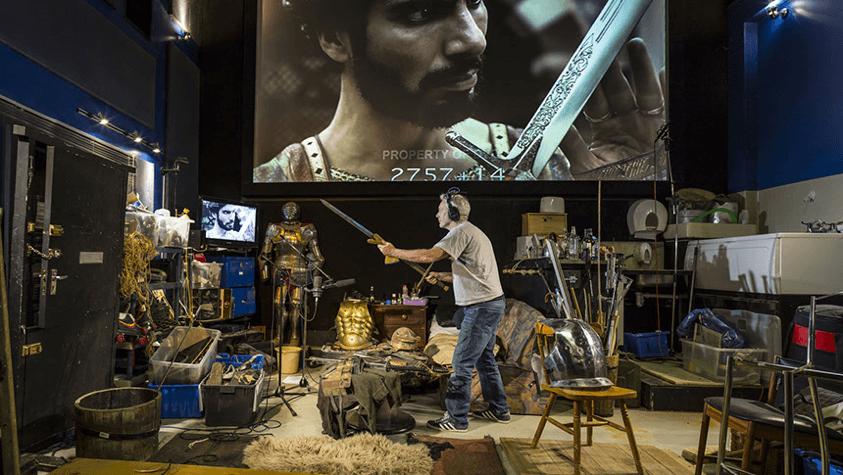By TACP Staff on July 26, 2021

Have you ever watched a movie and been propelled into fear by a sound effect? The creaking stair, the roaring thunder or the sound of a train’s brakes as they are hastily applied to avoid a child on the tracks? If so, you can thank a Foley artist. Foley artists reproduce sounds that occur in everyday life; sounds we otherwise hear, but take for granted. Utilizing specialized, post-production formatting and props; these artists ensure expert sound quality throughout the length of a project involving audio recordings.
Imagine yourself in a movie theater. You’re watching a scary movie with an actress walking down a deserted hallway in an old abandoned house. Her footsteps echo on the ancient dusty wood floor, and the door makes an eerie creaking noise as she slowly opens it…
Now, stop and think. Do you think those footsteps that you hear are really hers? Is that door really making that squeaking noise? The answer to both of those questions is “probably not”. Those sound effects are most likely the product of Foley art.
Foley art is the process of creating sound effects with everyday objects and adding them to movies and television productions. The microphones used during film production have a hard time picking up some necessary background sounds, like footsteps, so these must be added in later. Unlike other types of motion picture sound effects, Foley art must be created to match up with certain actions and movements of the actors.
Jack Foley is said to be the father of Foley art, to such an extent that this type of sound manipulation was actually named after him. Foley worked with Universal Studios at the beginning of the 20th century, when production studios were starting to make the switch from silent films to “talkies”, or films with dialogue and other sounds. One of the first films that Foley worked on and added sound effects to was the 1929 film Showboat.
Although many of the techniques that Foley used to create his sound effects were rather crude and seemingly primitive, many of them are still used in film production today.
Foley artists generally work in teams. They will usually watch and study the raw footage of a film and try to mimic the sounds that a character or a character’s actions would make.
Replicating a character’s footsteps is the easiest example of Foley art to explain.
In order to mimic the noise for a character’s footsteps, Foley artists will usually take into account what type of material the character is walking on, how fast the character is walking, and any gait abnormalities of the character. A microphone is then placed near the feet of a Foley artist as he walks in place on a hard surface, like wood or marble. The Foley artist trying to mimic this sound must have near-perfect timing so that his footsteps match up to the footsteps of the actor.
Some films may require a number of different character-specific sound effects at the same time. For instance, a scene in a movie may require footsteps, the swishing of fabric, keys jangling in a lock, and a gate opening. These are usually recorded separately, and they are then added to the final footage.
There are a few common techniques that Foley artists often use to recreate certain sounds.
Foley artists might also be called upon to fix a character’s dialogue, since background noises or microphone problems can often cause problems. In order to do this, Foley artists will usually have an actor come into the studio and record the missing dialogue. This can sometimes include entire scenes, but it can also include just single words or sentences.
Creativity and a good imagination are essential for a successful career in Foley art. The ability to think outside the box, so to speak, is also a necessary skill, since these types of artists will often need to come up with an unusual solution to create an ordinary noise. Aspiring Foley artists should also be very computer literate and comfortable working with a variety of different types of sound equipment.
While a formal education is not necessary to start a career in Foley art, it is often very helpful. Students interested in a Foley art career may want to consider earning degrees in audio production or recording arts.
Salary information for Foley artists is not collected by the Bureau of Labor Statistics. However, the website for the Bureau of Labor Statistics does mention that Foley Artists that are members of the Motion Picture Editors Guild is entitled to make a certain minimum wage. As of 2011, Foley artists who were members of this union were entitled to make at least $340 per day. Foley who are not members of the union may make much less, as will less experienced Foley artists.
Many Foley artists start their careers as apprentices, working under more experienced Foley artists. This will help them gain valuable hands-on experience, and it will enable them to network with other professionals in the film industry. They will often come in contact with different directors or producers, and if they are talented, they may be contacted for further work Experienced Foley artists might also be hired by production studios to work in the sound effects department on a full-time basis.
Consider these related careers in Music and Sound.

The Art Career Project is a trusted resource for emerging and professional artists.